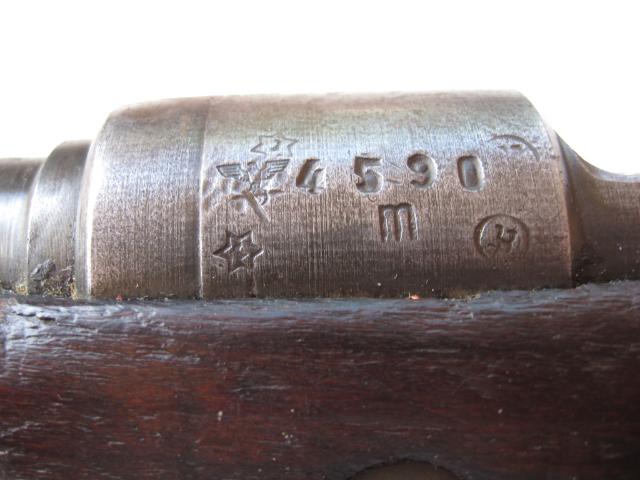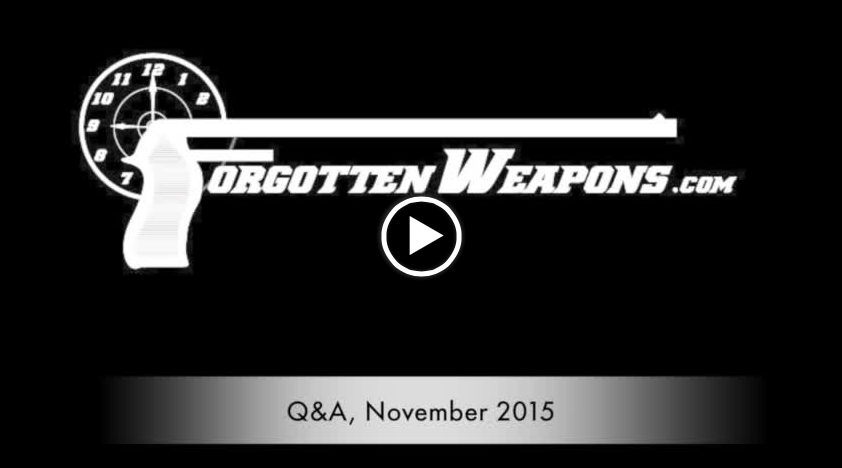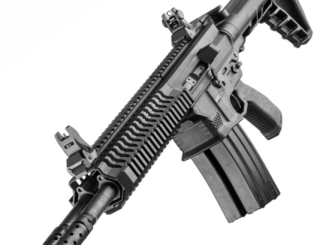If you had to pick three countries to focus your gun collection on, which would they be? Yeah, this is the sort of thing I think about when I’m waiting in line or otherwise unoccupied. Some countries have a reputation for junky guns, some for intricate ones, some for practical ones, and so on. I know it’s like choosing between your children, but have you ever considered which countries’ overall firearms history appeal to you the most?
I have, and I came up with an answer. I tend to like the unusual and guns with interesting stories, and that rules out the US and Russia and some other major centers of arms production. Yes, there are lots of amazing American and Russian guns, but I’m a bit too close to them and they don’t grab my interest the way some others do. The three I would choose (if I really had to choose) would be:
#3: Finland
True, the Finns haven’t done a lot of indigenous design – most of their arms have come from Russia. But what they’ve adopted from Russia has generally been worked over to make it better for the adept user. The result is a very cool combination of Finnish high quality and Russian rugged practicality. The Finnish M39 variation on the Mosin Nagant rifle, for example, is proof that you can make a silk purse form a sow’s ear. The SVT-40 carbine is a very cool piece too, and then you have some diverse unexpected things like the LS-26 light machine gun and imported Carcano carbines.
#2: Israel
I don’t have any scientific numbers, but I suspect that Israel has probably been involved in more actual live-fire combat per year and per capita than any other country. It shows in their armaments, too – if you want to be sure something works, look for an Israeli version of it. They have a predictably low tolerance for guns that don’t work. Their early equipment was a great (from my collector’s point of view) mish-mash of anything that could be bought or smuggled in – Mausers, FN-D and MG34 machine guns, High-Powers, and more. They continued to use a mixture of effective foreign guns (Browning 1919s, for example) and domestic production (like the excellent Galil interpretation of the AK and the iconic Uzi SMG). Finally, I think that a German-made K98k used in the Israeli War of Independence is just about the most symbolically significant firearm around.

#1: Czech Republic (and formerly Czechoslovakia)
The Czechs don’t have the hardscrabble combat history of the Finns and Israelis, but they have an often underappreciated history of making damn fine arms. Good steel, good workmanship, and a solid record of successful designs. The ZH-29 and ZK-420S, for example, are both excellent guns that just never made the big-time. The ZB-26 family – which includes the Bren Gun – is one of the best light machine guns ever made. The Vz-58 rifle, and the Vz-52 in 7.62x45mm. The CZ-75 family of pistols, which are arguably the best overall service handgun in production. I could go on, but suffice to say that the Czechs have made far more than their statistical share of excellent firearms.
Think I’ve got it all backwards? What would you chose?




1-Russia/Soviet Union
2-Israel
3-Switzerland
1) USA: John Browning; enough said. Winchester Arms.
2) Germany: Mauser Rifles used the all over the world. Walther Pistols, Elegant and functional.
3) England: Love those Express Rifles
I like your list, Ian. I could live with it. From a technical view, I like Czech guns the best, but as I open my safe, I see only two, and one is nothing special.
So if it’s to be only three nations, I’d like to be collecting Czech for the tech, Russian for the craftsmanship and design, and Israeli for the stories. I have managed Russian, Polish, and Swedish. I say Finland, but I’d have to put them fourth just because so much of their really fascinating stuff is prototype only. …of course, those Finn guns have tech, craftsmanship I like, AND stories…
Modern era, Post-WWII: USA, Austria, Soviet Union/Russia.
Pre-Modern era – 1884 – 1945: USA, Germany, England
Hummm,
I mostly collect handguns, I would have to go:
Spain
Argentina
Japan
No real order, and I can look a lot with my budget (just not buy)
Ed
USA, Germany, Russia/USSR
All Of Them? 😉
1. Switzerland;
2. France;
3. Finland.
1) Germanic. Meaning German spoken, including parts of Switzerland and the Habsburg Empire with nowadays Poland, Czech, Slovak, Hungarian and former Yugoslavian countries as well as Luettich, Mulhouse and Klingenthal; cold steel and 700 years of firearm history.
2) Japan. Odd stuff, Zen think.
3) Not sure, Israel or South Africa are new entries. For me Britain pulls a draw with the US of A on this and both might deserve the silver.
Zen was always a minority sect in Japan. Yanks conflate Shinto and half a dozen brands of Buddhism, add a dash of Dao, a dollop of Tibetan Bon, a whiff of Shamanism, adulterate with Theosophy and pronounce the melange “Zen.”
If I had my druthers, I’d collect U.S., Swedish and Belgian probably.
Surveying my “collection,” such as it is, would include:
1. USSR [Mosin-Nagant and SVT-40 and Yugoslav M57 Tokarev variant]
2. Finland [Mosin-Nagant]
3. USA [M1 Garand, carbine, rolling block, double-action revolvers]
4. France [MAS 36–the “Gallic Arisaka…”]
Mexico
Argentina
South Africa
If just 3, then Czechoslovakia, France and Russia.
1) Switzerland
2) Belgium
3) USA/CZ
4) Germany/Israel/Finland
5) Russia/France/South Africa
Yeah, Ian’s right – good guns suck as a collector’s subject. Weird guns are better 🙂
Folks, what about Danish Madsens, past and present? The rekyllriffel, the m/50 SMG, the Seatter? I don’t know what they were smoking then, but I’d rather pass the stuff. But – you have to admit, that in outlandish technology it would be like 3. Denmark, 2. France (just think of all these late 19th Century semi-auto and select fire rifles, the Chauchat, the St-Etienne, Le Francais pistols – even the post WW1 pistol contest and what transpired, the Mle 1935A and Mle 1935S, AAT, FA MAS. Now what these people smoked I’d really keep off), 1. Czechoslovakia, prior to 1948 Commie putsch which almost shaved their balls, and afterwards they turned to making good guns (although the SA-58 rifle or UK-59 machine gun are still in good’ole Puff-The-Magic-Dragon style). But a .380 full-size SMG (vz.38)? A .32ACP locked pistol? A DAO hinged slide and barrel ARMY pistol? Tomiśka Little Tom pistols with clips thrown UP through the slide when empty, Garand style? A 15 mm anti-tank rifle with barrel rotated and sliding by hand to reload by impaling chamber on the fresh round propped from the magazine? OK, thet had a slip or two, the ZB-26 and Bren, namely, but whoever is free from sin, let him first throw the stone, or something like that. They couldn’t always keep up the level, it would have been inhumane.
As me I go 1 Germans,2 Czech,3 Japanese,4 Finland,5 France,6 Britain…
I telling that becouse well experianced with majority of firearms and can say for sore thats Germans build simple guns with strong reliability and ease of meintanance and still building reliable stuff thats why other guns cannot compared to German manufacturing..
Dont really have any favorites but if i had to pick i would say Soviet Union, United States and Czech Republic cause i like originality and dont care so much for rip offs of previous designs no matter how refined.
1. Austria
2. U.S.
3. Belgium
Scotland
http://www.militaryheritage.com/pistol2.htm
with the Claymore broadsword and the Ross Rifle.
And Rev. Forsythe of Aberdeenshire came up with the percussion cup.
For me it is relatively easy:
From roughly 1885 up to 1918:
1. Germany
2. Austria-Hungary
3. France
From 1918 till the dawn of the Cold War:
1. Czechoslovakia
2. Switzerland
3. Germany/USSR
If strange and rare are valued points, I’d like to add Spain to my list, from roughly 1910 till the late 50s. Lots of interesting guns that never made past small series and/or experimental level, in most cases due to lack of vision from military high brass… By 1932, Spanish Oviedo arsenal designers had perfected a reasonably reliable selfloading rifle that could have been perfected further if the high ranked officers hadn’t interferred, fearing high ammo consumption by conscripts… Shortly after WW II, an entire family of selfloaders, battle rifles and assault rifles (they also tinkered with some handy carbines close in concept the M1 carbine, in 7,92×33 and .30 carbine) was built by Coruña arsenal, that just weren’t pursued because German technicians and their ideas became more chic and fashionable among military decision makers (Franco included, of course). The former weren’t worse or better than the prototypes built at CETME by Vorgrimler and his pals, just different.
When you point out Czechoslovakia, you ought to mention the Vz. 23 / Vz. 25 SMG.
http://en.wikipedia.org/wiki/Sa_vz._23
I think that was a modern gun way ahead of it’s time.
I would agree: telescoping bolt that but the magazine well inside the pistol grip. Ancestor of the Uzi. Even the Beretta Cx4 semi-auto carbine uses the principle started by the Vz23.
The Czechoslovaks shipped very many Vz23 and 25 9mm SMGs to Cuba, where these arms equipped the militia of the revolutionary state that defeated Assault Brigade 2506/ and the CIA at Girón/ Bay of Pigs, and the counter-revolution in the Escambray campaign.
Regular Cuban armed forces had Belgian FAL and Soviet PPSh and WWII-vintage U.S. weapons in the early 1960s.
The pro-revolutionary militia had the Czech VZ 52 7.62x45mm rifles, lmgs and Vz23 and 25 samopal 9mm SMGs.
1) Germany, but especially Mauser. I love their pistols. A drilling will always turn my eye as well.
2) Czech, interesting designs that are extremely well made.
3) Great Britain, I’d dearly love to be wealthy enough to collect the double guns & single shots that hunted for the empire.
Right. The Cuban military also had many Dominican-made Cristobal carbines, bought before the revolution. As for the FAL, it is interesting to note that the last shipment was delivered from Belgium to Cuba well after Batista was overthrown.
As for the vz. 52 rifles supplied by the Czechoslovaks, didn’t they also send the converted version, rechambered for the Soviet intermediate caliber? I understand that by that time the Czechoslovak military was busy arming their own rank and file with the vz. 52/57 rifle, at least until their own vz. 58 assault rifle became widespread among the troops, but since they got rid of the selfloaders quite quickly, I think some might have been sent to Cuba.
Great Britain – High quality, effective guns which are uniquely designed. I love my Webley autos!
Spain – Some high quality, some low quality, some conventional, some unique, and all with interesting history. I have a great little Tigre .44-40 lever action of the type used in the Spanish Civil War, some very interesting early Stars and Astras, and of course possibly the oddest handgun ever made, the Jo.Lo.Ar.
USA – Maybe a boring choice, but I’m just a sucker for old Colts. Espescially the parallel ruler autos.
Oh, and I almost forgot Belgium – not so much the weapons made for export but the weapons made for the Belgian Army – I’ve got a Mauser 1889 long rifle, 1889/16 carbine, and 1889/36 short rifle, as well as a Nagant 1878/86 revolver and they’re just beautifully manufactured guns just different enough from the more common models to be really interesting. I’d love to get a Belgian army issued FN 1900 but unfortunately the gun laws in Canada prevent it!
#1 The Basque Country of Spain. Eibar Steel rules.
#2 Belgium. Those guys know how to rip off an idea and run with it.
#3 China. Pre-Cultural Revolution. Think of the population base. There had to have been another John M. Browning in there somewhere.
Dean from Idaho
1 Holland development AR 10
2 germany Mauser c96 ,borchardt c93, Mauserk98
3 US colt 1911 (1905)
I’ll go with Leszeck on the influence of odd mushrooms and mystic herbs:
Italy; especially the late Emillio Ghisoni and his MATEBA and Ciappo revolvers.
Spain; Basque trash auto pistols, 9mm largo and Luger blowbacks, everything and anything Star has ever made, the Llama “Omni” and all sorts of uncontrollable machine pistols.
France, for engineering brilliance which was altogether too brilliant and crossed the boundary into insanity;
Gevarm open bolt .22 semi autos (excellent guns for the truck, you’re not scrambling around chasing dropped loaded rounds when you make the gun safe), Bretton and Darne shotguns.